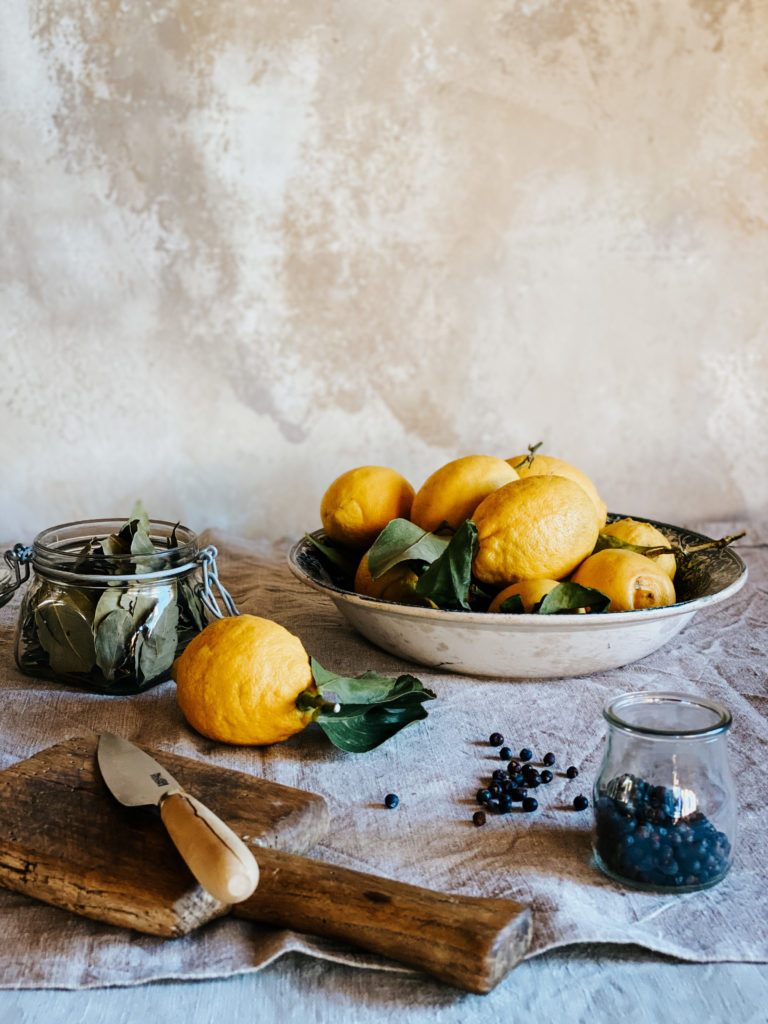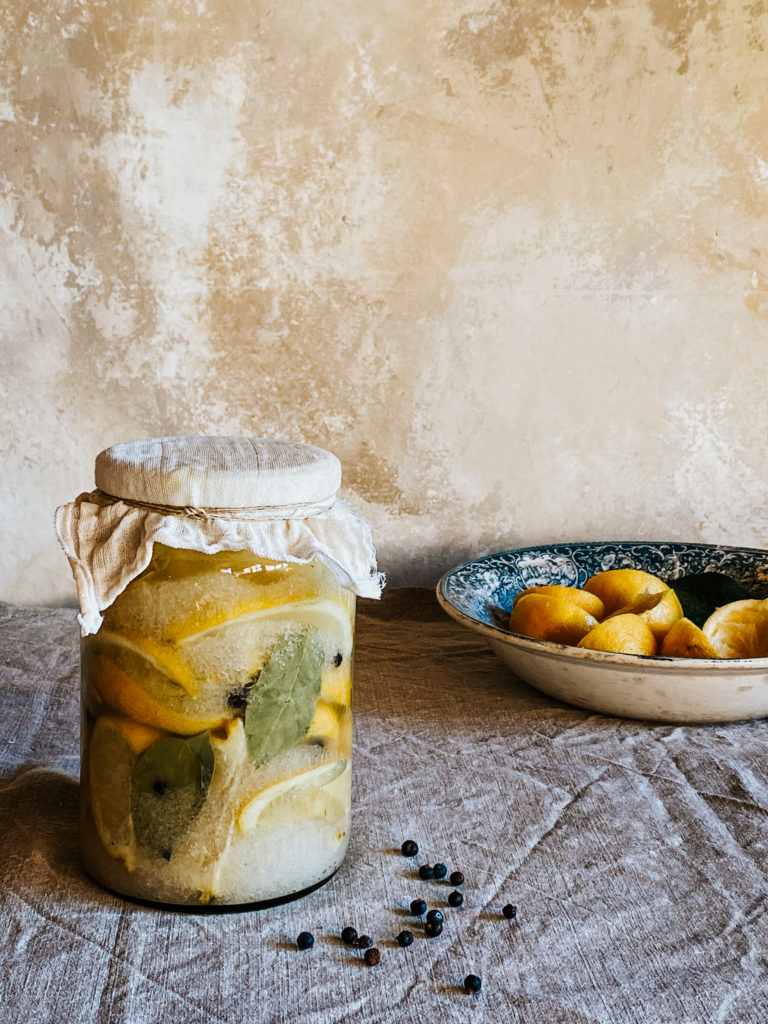The start of the citrus season always adds brightness and light to waning winter daylight. I am currently re-reading The Land Where Lemons Grow by English author Helena Attlee, which is transporting me to the citrus groves and scented gardens of Italy.
My winter larder is never without a large jar of salt preserved lemons with juniper and bay. Just a quarter provides a hit of bright, puckery flavour to winter meals and brings with it the promise of warmer days to come. It’s the perfect winter project that will quickly become a winter ritual.
Preserving lemons is a kitchen ritual I look forward to each winter, when citrus is abundant. The floral scented and tender flesh of cured citrus adds a pop of salty, bright, tangy punctuation and luxury to simple bowls, dressings, sauces and dips, and I love to have them on hand in my pantry year round.
It’s really important to use lemons that are organic and unwaxed with a nice bloom to the skin. Sicilian or Meyer lemons are ideal because they are naturally fragrant with numerous essential oils in their peel. There are different ways you can prepare citrus for curing in this way; they can either be left whole, halved, quartered, or sliced. Curing whole fruit will take longer, with sliced fruit being ready in the shortest time. I like quarters, because they seem to me to be the ideal size for one or two recipes, but it’s a personal choice, so choose what feels right to you.
Using good salt is vital. I like to use coarse sea salt or kosher salt for curing. I tend not to use a set amount, but as a rough guide, 500g of salt is about right for a 1 litre jar. The important thing is to be generous. All cut sides of the fruit should be rubbed in the salt, and in between each layer as you fill the jar. I love to add juniper berries and bay leaves to the jar as I’m layering, for some extra aromatic loveliness, but black peppercorns are also simple and nice.


Salt Preserved Lemons with Juniper & Bay
- Yield: For a 1 litre jar 1x
Ingredients
10 lemons (about 1kg)
Coarse sea salt (about 500g)
8 juniper berries
4 bay leaves
A little extra virgin olive oil (to seal)
Instructions
Wash and rinse a 1 litre jar and lid. Dry well with a clean tea towel.
Scrub the lemons, rinse and dry well.
Cut 6 of the lemons into quarters, lengthwise.
Spoon 2 tablespoons of salt into the jar. Pour the rest into a large bowl.
Rub each cut side of the quartered lemons in the salt bowl and begin to pack inside the jar.
Arrange the lemon quarters in layers distributing the bay leaves, juniper berries and extra salt evenly among the layers. Push down the lemons as you go with the end of a rolling pin or a small ramekin, to release their juice.
Finish with some more salt, leave space at the top (3 inches or so).
Halve and juice the remaining lemons. Pour over the lemons and salt making sure the lemons are fully submerged (I like to weigh down the lemons with a small plate or glass weight to fully submerge them).
Seal the jar and set in a cool, dark place for 4 weeks.
For the first 2 weeks, shake the share every day, checking that the citrus are still submerged under the briny liquid.
At the end of the 2 weeks, open the jar and pour just enough extra virgin olive oil to cover. This will act as a seal and prevent any mould from forming.
Return the jar to a cool, dark place for a further 2 weeks (you don’t need to shake the jar during this time).
After 4 weeks, open the jar and test the lemons. They are ready when the flesh is tender and almost translucent, but not mushy. You can continue to cure the citrus for a further 3 months for extra depth of flavour, if you can wait that long.
They will keep for up to a year in a cool, dark place. Each time you remove a preserved lemon quarter from the jar, replenish with a little extra salt and lemon juice to keep the citrus covered.
To use, rinse the preserved lemon briefly in water to remove any excess salt. You can eat the whole fruit, rind and flesh, finely chopped.
Ways to use preserved lemons
- Grain Salads: There’s something wonderful about little nubs of preserved lemon in a forkful of quinoa salad or in a wholegrain rice bowl that feels bright and sunny. Any time you’d normally add some citrus zest, consider using preserved lemon instead for extra special tanginess.
- Salad Dressings and Sauces: Blending a piece of preserved lemon into a salad dressing or nutrient dense sauce, such as pesto, adds a punchy, bright hit to simple greens salads or bowls.
- Salsas and Dips: Finely chop preserved lemon into your favourite recipes; smashed avocado, hummus, salsa verde. All delicious.
- Pasta Bowls: A simple gluten free tagliatelle with good olive oil, some garlic, a few capers, some soft herbs or sautéed greens, and a piece of finely chopped preserved lemon is a beautiful thing. Top with some oven-roasted chickpeas to round out the meal.
- Stews and Soups: One pot stews and lentil soups are elevated when you add a touch of preserved lemon. Tagines are well-known for this, but really any dish with a nourishing chunkiness to it works. Be experimental and tweak.
- Umami Boost: Umami is a Japanese term for savouriness and often referred to as the 5th taste in addition to sweet, sour, salty, and bitter. A preserved lemon become the best plant-based umami flavour bomb. Once cured, its sourness diminishes, but its lemon-ness is sharpened, levelling itself up as an instant umami-rich version of a lemon when you want to add complexity to any dish and liven your taste buds.
For more winter recipes, rituals, everyday staples, and to access my library of wellness offerings join my online Membership here.
Click here to register today
